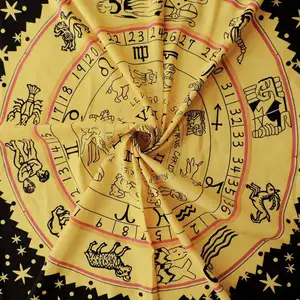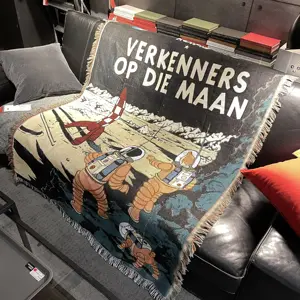
All categories
Featured selections
Trade Assurance
Buyer Central
Help Center
Get the app
Become a supplier

(180 products available)









































Celtic tapestry is a traditional textile art form that originated in the ancient Celtic cultures. These tapestries are known for their intricate designs, rich symbolism, and vibrant colors. They often depict scenes from Celtic mythology, nature, and history, woven with great skill and artistry. Celtic tapestry is characterized by its use of high-quality materials such as wool, silk, and linen, resulting in durable and beautiful pieces that can be used as wall hangings, clothing, or decorative items. The tapestries reflect the Celts' deep connection to their heritage and the natural world around them. Crafted with care and precision, Celtic tapestry continues to be appreciated for its timeless beauty and cultural significance.
Additionally, a Celtic tapestry can be a more affordable option than other home decor items. For instance, a wall tapestry can add color, texture, and visual interest to a room, all while being cost-effective. Moreover, hanging a large wall tapestry is much easier than painting or wallpapering an entire wall. It is also less likely to damage the wall.
Tapestries are textile art forms created by weaving threads together to form designs or images. They have been used for centuries to decorate walls, furniture, and clothing. There are many different types of Celtic tapestries, each with its unique style and history. Some commonly known types include:
Celtic tapestry wall hanging
Celtic tapestry wall hangings are decorative textiles that often feature intricate designs inspired by Celtic art and culture. They can be used to adorn walls in homes, offices, or public spaces.
Celtic tapestry cushion cover
Celtic tapestry cushion covers are decorative pillow covers that often feature intricate designs inspired by Celtic art and culture. They can be used to adorn cushions in homes, offices, or public spaces.
Celtic tapestry throws
Celtic tapestry throws are decorative blankets or shawls that often feature intricate designs inspired by Celtic art and culture. They can be used as bedspreads, sofa covers, or wraps in homes, offices, or public spaces.
Celtic tapestry fabric by the roll
Celtic tapestry fabric by the roll is a type of textile that features designs inspired by Celtic art and culture. It is sold in rolls, allowing for larger-scale use and application. This type of fabric may feature intricate patterns, such as knotwork, animals, or foliage, which are characteristic of Celtic art. It can be used for various purposes, such as making clothing, wall hangings, upholstery, or other home decor items.
Knots and Interlacing
Celtic knot tapestries feature intricate knots that symbolize eternity, unity, and interconnectedness. They have loops that intertwine without ends, creating complex geometric designs. Some knots are simple and small, while others form large elaborate patterns covering the whole tapestry.
Spirals and Whorls
These designs have spirals that suggest motion and growth. They often form circular whorls or spiral patterns spread across the tapestry. The spirals may represent natural elements like the sun, moon, and seasons.
Animal Motifs
Animal tapestries show creatures important in Celtic culture. They include designs of deer, birds, and mythical beasts like griffins and dragons. The animals are often woven in a stylized way, with interlaced lines and shapes emphasizing their grace and power.
Tree of Life
The Tree of Life tapestries represent the connection between earth, sky, and the spirit world. They usually show a tree with roots, branches, and leaves woven in great detail. The tree symbolizes harmony, balance, and the interconnection of all living things.
Mythological Scenes
Some tapestries depict stories from Celtic myths and legends. They show heroic deeds, legendary figures, and important events illustrated richly and artistically. These tapestries are like storybooks that bring ancient myths to life through weaving.
Geometric Patterns
Geometric tapestries have straight lines, symmetrical shapes, and repeating patterns. They provide a sense of order and balance and go well with other designs. The geometric shapes are often combined with knots and spirals to create complex visual effects.
Home Decor:
Celtic tapestry can be used as a wall hanging to add a focal point in a room. It can be placed in living rooms, bedrooms, or even hallways to instantly uplift the decor of the space. These tapestries can also be used to cover an entire wall for a dramatic effect, or they can be layered with other wall decor for a more eclectic look.
Furniture Upholstery:
Using Celtic tapestry to upholster furniture pieces like chairs, sofas, or ottomans can breathe new life into old furniture and make a bold decorative statement. It is a durable fabric, so it is suitable for furniture upholstery that withstands regular wear and tear.
Decorative Accents:
Celtic tapestries can be used to create decorative items like cushions and pillow covers. They provide comfort and add an artistic touch to living spaces. Additionally, small tapestry pieces can be used as tabletop accents, such as on dining or coffee tables, to make unique focal points.
Clothing and Accessories:
Celtic designs can be incorporated into clothing and accessories through tapestries. Items like capes, shawls, bags, or even hats can feature the intricate patterns and rich colors of tapestry, allowing people to carry a piece of art with them wherever they go.
Artistic Displays:
Displaying Celtic tapestry as standalone pieces can highlight their beauty. They can be framed like paintings, or displayed on easels, or draped over furniture as artistic statements in galleries, museums, or personal art collections.
Event Decor:
Celtic tapestries can add an event's atmosphere, such as weddings, banquets, or themed parties. They can be used as backdrops, table runners, or drapery to create a sense of place and complement the event's theme.
Craft and DIY Projects:
Tapestry fabric can be used in various craft and DIY projects. It can be combined with other materials to create unique, personalized items like wall hangings, photo frames, or gift wraps.
Consider the Material:
Celtic tapestries are made from various materials. Cotton is often used for its affordability and ease of care. Wool gives a warmer, more textured feel. Silk makes things look fancy with vibrant colors. Look at the material to fit the tapestry’s use.
Design and Theme:
Celtic tapestries have unique designs. Pick one showing Celtic symbols, nature motifs, or tribal patterns that fits the desired atmosphere. Consider what historical or cultural elements are important to highlight.
Size and Proportion:
The tapestry should fit the space without overwhelming it. Measure the area where it will hang or lie. Compare the dimensions of the tapestry. For wall hangings, consider the height at which it will be displayed.
Quality of Craftsmanship:
Examine the details. A good tapestry will have clear images. The edges should be neat. Ask about the quality before buying. Well-made tapestries last longer and look better.
Care and Maintenance:
Find out how to take care of the tapestry. Some may need special cleaning due to their delicate fibers. Knowing the maintenance requirements helps avoid damage and keeps it looking nice.
Purpose and Placement:
Think about why the tapestry is being used. Is it for decoration, warmth, or hiding walls? The purpose affects the material and design choice. Where it will be placed also matters. Tapestries for rooms need durable materials, while those for walls can be more fragile.
Q1: What are the benefits of celtic tapestries?
A1: Celtic tapestries are durable; they tell stories; they add a cultural touch to a room; they are great decorative pieces, and they can be used as room dividers.
Q2: How should one hang a celtic tapestry?
A2: One can hang a celtic tapestry by folding the top over a rod or dowel, using tapestry clips or pins, or using adhesive wall hangers.
Q3: How can one take care of a celtic tapestry?
A3: To take care of a celtic tapestry, gently vacuum it, spot-clean it, and rotate it regularly.
Q4: Where should celtic tapestries be placed?
A4: Celtic tapestries can be placed on walls as decorative pieces, in a living room, or as a bed cover.
Q5: Are celtic tapestries modern or antique?
A5: Celtic tapestries can either be modern or antique.